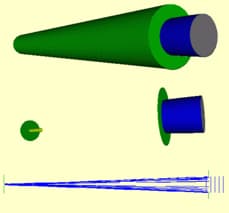Advanced Example xray_telescope
Responsible Geant4 Collaborator: Giovanni Santin, European Space Agency, The Netherlands.
Short description
This is a real-life Geant4 application for the simulation of a typical X-ray telescope, equipped with interactive UI and analysis tools for histogramming and advanced visualisation capabilities. The example is of general interest also for applications in other domains.
Geometry and Physics
Views of the X-ray telescope can be seen in Figure 1.

The telescope mirror consists of a single shell grazing incidence mirror (depicted in blue) made up of two parabolic and two hyperbolic mirror sections made in nickel with a gold coating on their inner surfaces. An aluminium stop (shown in grey) limits the telescope aperture gap to 2 mm along its entire length. On the bottom pannel the main carbon fibre telescope tube has been left out to show the focal plane, which consists of a silicon detector (used to represent a CCD) inside a conical titanium baffle. The full geometry can be viewed in VRML. In an example run an isotropic distribution of 106 500keV protons was released within a small annular region around the telescope aperture. The physics of interest in this case is the propagation of protons through the X-ray mirrors through multiple scattering processes. The bottom panel shows the tracks of 27 protons that actually reach the detector at the focal plane.
Visualisation
The example shows how to produce:
- high quality postscript output and
- VRML files for the web
User Interface
The example shows how to set-up:
- an advanced flexible GUI to configure the set-up and control the execution,
- Geant4 GUI and Environments G4UIJAG, JAS, Java-2 and GAG.
Last updated: 18/02/2022 by S. Guatelli